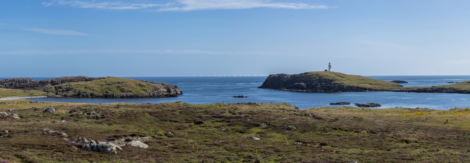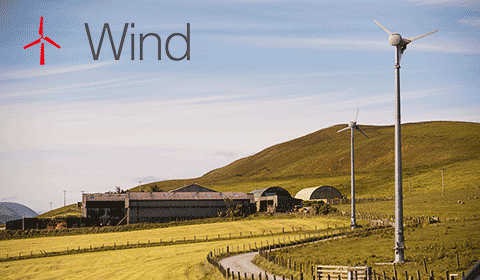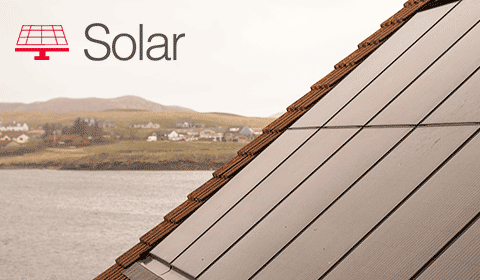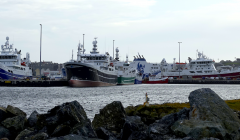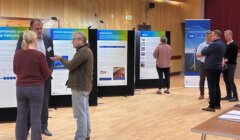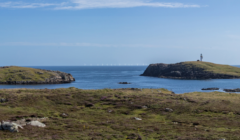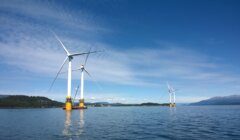Energy / Scoping report ‘milestone’ for offshore wind farm
A SCOPING report has been released for the offshore elements of a proposed floating wind farm to the east of Shetland – but questions over the finer details still remain unanswered.
The report on ESB’s proposed Stoura offshore wind farm, which has been submitted to Marine Scotland, has been described as a “key milestone” for the project.
It gives some basic details about what offshore infrastructure may be involved in the 500MW development – such as 40 turbines, which could be 385 metres high to the tip, and an offshore substation platform – but no confirmation over cable routing at sea or where exactly the export link would make landfall in Shetland.
However Yell Sound appears to be a key possibility for routing as the cabling gets closer to land – not too far from where SSEN could build a new “hub” in the North Mainland.
This hub could include a new HVDC converter station and AC 400kV substation that would be able to receive power from the two offshore wind farms planned to the east of Shetland – Stoura and the larger Arven – as well as facilitate large-scale planned hydrogen production, and also feed as much as 1.8GW into the national grid through a second HVDC subsea cable.
The ESB scoping report confirms that the Stoura construction programme will “need to align to availability of the onshore grid infrastructure, which is separate to the project and currently anticipated to be delivered in 2035”.
“As such the offshore project programme will be refined as confirmation is provided on grid infrastructure but is expected that it will take approximately five years for construction of the offshore project, taking into consideration suitable weather windows.”
It says there would be a maximum of two export cables, which would be no greater than 140 kilometres in length.
Become a member of Shetland News
The report also does not provide precise specifications for infrastructure as there is an apparent risk that if technology is mentioned in the consent application it could become “outdated, leading to a project that may be uneconomical or even unbuildable”.
The scooping report touches on many possible impacts that construction and operation of the wind farm could bring.
A key concern has always been around the impact it could have on fishing grounds in the area.
The report highlights that there would be “reduction in access to, or exclusion from established fishing grounds” during all phases.
Other impacts for fishing mentioned include increased snagging risk, and displacement of fishing activity leading to pressure on adjacent grounds.
A number of possible mitigation measures are included in the report, including the appointment of a fisheries liaison officer and a series of plans on construction and environmental management.
The report says there will be continued consultation with a wide array of fishing groups and representatives, and it confirms commercial fishery stakeholders will be engaged with during the scoping exercise.
ESB said the scoping report is the next step following analysis and consultation conducted since October 2022, and that it has been informed by feedback received through public engagement and three scoping workshops.
The report outlines in detail the approach and methodologies that the Stoura team propose to follow to develop an environmental impact assessment for the offshore elements of the project.
“The submission of our offshore scoping report is a key milestone for the Stoura Project” said Dr. Cian Desmond, project director at ESB.
“Since 2022, we have had the privilege of engaging directly with Shetlanders through regular formal meetings, public consultation and stakeholder workshops.
“The insights gathered through these engagements have been invaluable in shaping our approach. We are keen to continue this open and constructive dialogue and see this consultation as another opportunity to help guide the project.”
A separate scoping report addressing the onshore elements of the Stoura project will be prepared and submitted at a later stage.
The much larger Arven wind farm, proposed to be located to the south and south west of Stoura, would have a generating capacity of up to 2.3GW.
An offshore scooping report was submitted last year for that project.
However since then one of Arven’s two partners – Mainstream Renewable Power – has left the project.
A spokesperson for the wind farm said last month: “The Arven offshore wind project is in the early stages of development, with operations not expected to commence until the mid-2030s.
“Despite these changes, the project continues to represent a significant long-term opportunity for clean energy growth and regional economic benefit.
“Ocean Winds remains committed to the success of the Arven project and our current focus is on ensuring continuity. We will continue to keep our supply chain partners, local communities and wider stakeholders informed as the project progresses.”
Both offshore wind farm sites featured in Crown Estate Scotland’s ScotWind leasing process.
There were initially three separate sites to the east of Shetland but two of them combined to form Arven.
Become a member of Shetland News
Shetland News is asking its readers to consider paying for membership to get additional perks:
- Removal of third-party ads;
- Bookmark posts to read later;
- Exclusive curated weekly newsletter;
- Hide membership messages;
- Comments open for discussion.
If you appreciate what we do and feel strongly about impartial local journalism, then please become a member of Shetland News by either making a single payment, or setting up a monthly, quarterly or yearly subscription.




